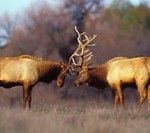By Juliana Barbassa
 LOS BANOS, Calif. — Dozens of tule elk will be sent to areas where they can roam freely, from the northern Coast Ranges to the southern Sierra Nevada, in an attempt to restore a native California species that has rebounded from the brink of extinction.
LOS BANOS, Calif. — Dozens of tule elk will be sent to areas where they can roam freely, from the northern Coast Ranges to the southern Sierra Nevada, in an attempt to restore a native California species that has rebounded from the brink of extinction. "We were down to an Adam and an Eve, for all we know," said Jon Fischer, head of the elk capture project for the California Department of Fish and Game. "This has been a real success story."
State and federal wildlife officials captured about 35 elk Wednesday from the San Luis National Wildlife Refuge, a fenced-in range that is surrounded by farm land about 80 miles northwest of Fresno. The animals will be moved through Thursday.
Tule elk are the smallest of the three species in the state, but a bull can still reach 1,000 pounds.
In the refuge's marshy grasslands, turned muddy by recent rain, a helicopter flew over the galloping herds Wednesday, dipping close to the ground and firing a weighted net when an elk separated from the others. Officials tried to avoid using tranquilizers. Once an elk was netted, members of a field team tackled the animal, bound its legs and covered its eyes to keep it from panicking.
The elk were measured, weighed and checked for disease before being herded into a truck.
"This is the glamorous part of the job," Department of Fish and Game biologist Rebecca Barboza said after processing a young male elk, her boots and jacket splattered with mud.
Tule elk exist only in California, where they once roamed the San Joaquin Valley and the foothills of the Sierra Nevada.
Gold miners and the first farmers to move into the marshy lowlands found a population estimated at 500,000. By the 1870s, farming and hunting had narrowed the elk's habitat and thinned the herds.
By the 1970s, only about 500 tule elk survived across the state, prompting biologists to start transplanting some of the survivors to the San Luis refuge.
There now are about 3,700 tule elk grazing in their original habitat, enough to allow limited hunting in certain areas.
The 760-acre refuge proved such a good home for the elk that Fish and Game officials have taken animals from the area to re-establish or supplement other herds several times since 1978.
Still, controlling the population is important because the growing herds can interfere with surrounding farms or wander into ever-expanding suburbs.
Tule elk are not listed as threatened or endangered. State and federal biologists said they expect the population to remain at its present size.
"We just can't have 500,000 elk again," Fischer said. "Environmentalists, hunters, farmers -- we have to keep all these interests in balance."



